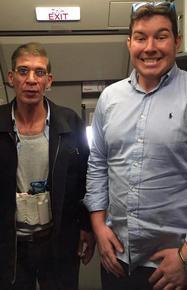Selfies, it seems, are no longer simply the domain of teenagers, celebrities or politicians, but are also a means of social media-ising a terrorist situation. What a bizarre world we live in. Thankfully, the hijacker was no real threat (he was simply trying to see his estranged wife, apparently) and the passengers were left unharmed. But what are we to make of this selfie-obsessed world? Where did they come from, and how have they changed our behaviour?
The origin of the selfie

It may feel like selfies have been about forever, but the first instance of the term ‘selfie’ was in 2011, only five years ago. In 2012, the word was named by Time Magazine as one of 12 new, breakthrough words, and it was voted word of the year by the Oxford Dictionary in 2013. The use of the word rose 17,000 per cent in 2013.
Advances in technology are often responsible for huge shifts in human behaviour. In a paper called Selfies shape the world, Brent Fausing explores a similar shift after the invention of the mirror during the renaissance period, and the impact it had on the portraiture of the time. With the mirror came a perception of ourselves from the outside, and the ability to see ourselves as other people do. This led to a heightened interest in the individual, and the individual becoming the focus of paintings in the period, as opposed to settings and families. Small easel paintings began to take over from large murals, allowing a different gaze from the observer and liberation in techniques. Fausing makes the point that, in a similar way, the invention of the swivelling camera has changed the photos that we take; the focus, once again, has shifted to the individual.

The other technological development which has precipitated the rise of the selfie is the introduction of ‘likes’. Launched in 2009 as a small thumb, Facebook forever changed the feedback and response mechanism on its pages. Instagram, launched in 2010, included a similar ‘love’ option, and Twitter used what began as a ‘favourite’ star (more akin to pinning a tweet to save for later) but has now moved to a heart-shaped ‘like’. The combined effect of all of the above is that we expect a response to what we post now, and maybe even post things for the sake of the response. I’ve known young people to post selfies on Facebook, only to delete them an hour later when they’ve had no responses. The response is everything.
The impact of the selfie
How has the rise of the selfie impacted our behaviour, and the way we view ourselves? It may not be wholly negative. Human beings are drawn to faces, a fact proven by numerous psychological and sociological studies; we are born this way and it is essential for our survival. It is therefore not surprising that we are drawn to taking pictures of our own faces, and drawn to pictures of other people’s faces. If you update your status on Facebook using only words, and then communicate a similar thing via a selfie, it’s likely that the latter would draw more attention. So in many ways selfies are a natural product of the human condition and our desire to be looked at and noticed.
However, I’ve noticed a couple of things about the way my young people (particularly the girls) use selfies as a way of bolstering their self-esteem you may have witnessed something similar. They will post an evidently highly-orchestrated picture of themselves, with full make up, flattering lighting and optimum angle on Facebook or other social media site. Then their friends (mainly girls) will like and comment underneath saying ‘You’re so pretty!’ or something similar. Then they will reply to these comments saying ‘Shut uuuup, no I’m not, you’re prettier!’ And so on. It’s essentially young people testing and crowd-sourcing opinion for how they should feel about themselves. They evidently do think that the picture looks nice, otherwise they wouldn’t have posted it. And they are (I would think) pleased to hear the positive comments. But it is a particularly unique phenomenon of our time that this seeking of approval and testing of self-worth is being played out in a public sphere among teenagers.
Another concern is what this overt objectification of ourselves is doing for our sense of self. Philosopher Jean-Paul Sartre talked about the alienation we feel as a consequence of the distinction between who we are in and of ourselves, and how we appear to others. We live in a funny time in the history of the world where people are starting to project and control and filter and manipulate what it is that others see more than ever before, in an attempt to harness and maybe even identify with the image they are projecting. Never before have we been so aware of how we look to others, and never before have we been so able to manipulate what they see. Our hidden lives and who we are beyond the lens are at risk of being ignored and devalued while we pour our energies into the perceptions people have of us. I can’t help but feel this will lead to a deeper sense of alienation and disconnection and more fragile self-worth than we have ever known before. Time will tell what the impact of this behaviour, played out online, truly is. Hopefully it’s just a phase, and hopefully people will get bored of pictures of the same pout in different locations, again and again, and start to turn their cameras outwards. Until then, here are some thoughts for the journey for those of us who work with, and set an example for, young people:
- How much of our lives are projected online?
- How are our hidden lives doing?
- How do you react to a young person posting a selfie online?
- What do you think the best possible way to respond is?












































